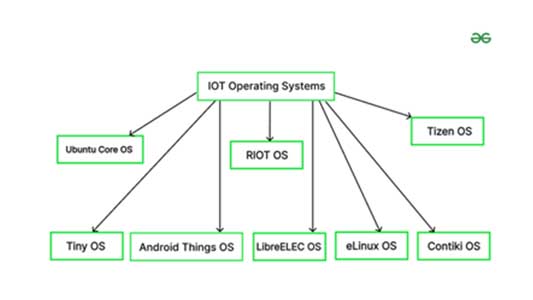A current trend in the IoT operating systems market is rising adoption of IoT in healthcare. A device with a sensor that can communicate with the real world and transmit data to the Internet is referred to as an IoT unit. These devices can collect various patient data and receive feedback from medical professionals in the field of healthcare. One successful application of IoT in healthcare is Continuous Glucose Monitoring (CGM) for insulin pens used by diabetic patients.
The global IoT Operating Systems Market was valued at US$ 635 Mn and is expected to reach US$ 20 Bn by 2030, growing at a CAGR of 38% during the forecast period.
Understanding IoT Operating Systems
IoT devices come in various shapes, sizes, and functionalities, each with specific requirements for processing power, memory, and connectivity. IoT operating systems are designed to meet these diverse needs while providing a robust platform for developing and deploying IoT applications. Unlike traditional desktop or mobile operating systems like Windows, Linux, or Android, IoT operating systems are optimized for resource-constrained devices with low power consumption and limited processing capabilities.
Key Features of IoT Operating Systems
- Resource Efficiency: IoT devices often have limited resources such as CPU power, memory, and storage. IoT operating systems are designed to operate efficiently within these constraints, ensuring optimal performance while conserving energy.
- Real-time Capabilities: Many IoT applications require real-time processing and response capabilities, especially in industrial automation, healthcare monitoring, and smart infrastructure. IoT operating systems incorporate real-time features to handle time-sensitive tasks promptly.
- Connectivity Support: IoT devices rely on various communication protocols such as Wi-Fi, Bluetooth, Zigbee, and LoRaWAN to connect to networks and other devices. IoT operating systems provide built-in support for these protocols, simplifying device connectivity and interoperability.
- Security Features: Security is a paramount concern in IoT deployments due to the potential risks associated with data breaches, unauthorized access, and device tampering. IoT operating systems offer robust security mechanisms such as encryption, authentication, and secure boot to protect IoT devices and data.
- Scalability: IoT ecosystems often involve thousands or millions of connected devices. IoT operating systems are designed to scale efficiently, allowing seamless management of large device fleets and distributed deployments.
- Over-the-Air (OTA) Updates: Maintaining and updating IoT devices can be challenging, especially in remote or inaccessible locations. IoT operating systems support OTA updates, enabling software patches, feature enhancements, and security fixes to be deployed remotely.
Popular IoT Operating Systems
- FreeRTOS: FreeRTOS is a popular open-source real-time operating system designed for microcontrollers and small embedded systems. It provides multitasking capabilities, low overhead, and a rich set of libraries for IoT development.
- Linux-based OS: Several Linux distributions have been adapted for IoT devices, including Ubuntu Core, Yocto Project, and Raspbian (for Raspberry Pi). Linux-based IoT OSs offer a familiar development environment, robust networking capabilities, and extensive software libraries.
- ARM mbed OS: mbed OS is a lightweight, open-source operating system specifically designed for ARM-based microcontrollers. It supports IoT connectivity standards like MQTT, CoAP, and LwM2M, making it suitable for a wide range of IoT applications.
- Zephyr RTOS: Zephyr is a scalable, open-source RTOS optimized for resource-constrained devices. It supports multiple architectures (ARM, x86, RISC-V) and provides a modular architecture that allows developers to customize features based on device requirements.
- Contiki OS: Contiki is an open-source operating system designed for IoT and embedded systems. It offers low memory footprint, IPv6 networking support, and a range of communication protocols, making it suitable for IoT deployments with constrained devices.
Importance of IoT Operating Systems
- Device Management: IoT operating systems simplify device provisioning, configuration, monitoring, and maintenance, allowing organizations to manage large fleets of devices efficiently.
- Application Development: By providing APIs, SDKs, and development tools, IoT operating systems accelerate the development of IoT applications, reducing time-to-market and development costs.
- Interoperability: Standardized IoT operating systems promote interoperability among devices and platforms, enabling seamless communication and data exchange in heterogeneous IoT environments.
- Security Compliance: IoT operating systems implement security best practices such as encryption, secure boot, and access control, helping organizations meet regulatory requirements and protect sensitive data.
- Scalability and Flexibility: IoT operating systems support scalable deployments and flexible architectures, allowing businesses to adapt to changing requirements, add new features, and integrate with cloud services seamlessly.
Challenges and Future Trends
Despite their advantages, IoT operating systems face challenges such as security vulnerabilities, device diversity, interoperability issues, and complex ecosystem integration. Future trends in IoT operating systems include enhanced edge computing capabilities, AI/ML integration for intelligent IoT applications, improved security frameworks, and standardized protocols for seamless connectivity and interoperability across devices and platforms.
These insights are based on a report on IoT Operating Systems by Transparency Market Research












